Behind the Art
Jonas Wood in Hong Kong
Join Jonas Wood on a virtual tour through the creation of his first solo exhibition in Hong Kong. Wood narrates the genesis and development of the new paintings, drawings, and wallpaper.
Summer 2018 Issue
Jonas Wood’s first survey of prints premiered at Gagosian, New York, in 2018. For the occasion, the artist spoke with Jacob Samuel, a legendary printmaker based in Los Angeles, about the development of Wood’s printmaking practice and its influence on his paintings.
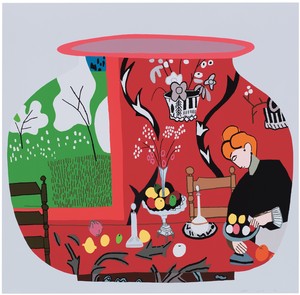
Jonas Wood, Matisse Pot 2, 2018, 30-color screen print on Rising museum board, 27 ½ × 28 inches (69.9 × 71.1 cm), edition of 50 © Jonas Wood. Photo: Brian Forrest
Jonas Wood, Matisse Pot 2, 2018, 30-color screen print on Rising museum board, 27 ½ × 28 inches (69.9 × 71.1 cm), edition of 50 © Jonas Wood. Photo: Brian Forrest
Jonas WoodYou and I started working together three or four years ago, around 2013 or 2014. And in the last couple of years you helped me start my own print house, WKS Editions. We were thinking about setting up a whole silkscreen studio. And then we realized that it’s probably best to find people who are excellent at this who we could, not collaborate with, but outsource the work to, and that actually became a much better plan for us. Now we are working with Kevin Giffen and Daniel Wlazlak.
Jacob SamuelKevin worked with the silkscreen printer Jeff Wasserman—
JWYes, and he was looking to work for artists. So we didn’t have to create a whole setup. In the last year we’ve been making detailed prints, with about thirty colors, of red Matisse pots. We’re re-creating works of mine that already exist, but making hybrid versions with more immediate drawing on top.
JSWell, one of the great things about printmaking is that you can edit. You can add and subtract.
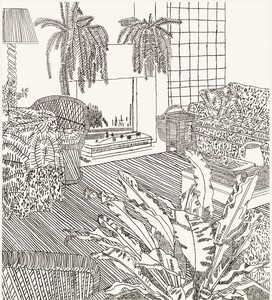
Jonas Wood, Untitled (from 8 Etchings), 2014 (detail), ink on Japanese paper, in 8 parts, each: 16 × 14 inches (40.6 × 35.6 cm), edition of 10. Photo: Brian Forrest
JWExactly. So it’s perfect, because now we’ve started to work with them, and we can use their studio to make my prints. We didn’t have to create a whole setup. The only thing that we had to set up was the etching studio. That was when you and I decided to work together and you became my spiritual and professional printmaking guru.
JSYes. [Laughs] Exactly. You know, we met earlier, though. The show of your [Alexander] Calder plants was up at the Hammer Museum in Los Angeles at the same time that my archive was on view there.
JWYes, 2010. But we didn’t know each other yet.
JSWell, we met briefly at the reception, but we didn’t really get to talk.
JWAnd in spring 2013 you invited me over to your studio in Santa Monica. You were working on a Christopher Wool project.
JSI’ve been working with Christopher for almost twenty years. It was interesting to me that you wanted to try line etching as it was something completely different for you. And what I really liked was that you took your time learning how to draw on the plates.
JWYeah, there was a big learning curve.
JsYes, but you were willing to do it. And you used lots of different drawing tools until you found things you were comfortable with. You have lines that are very strong and thick, so you weren’t going to get that thickness just through etching. You actually needed to get it through the drawing tool and then etching it deep.
JWI remember—you gave me a little practice plate and before I really started, I was doodling on it and I was like, “Can we print this practice plate?” and you were like, “Fuck no. We’re not going to print this practice plate” [laughter]. There was nothing—there was no image. It was just a bunch of scribbles. I was overwhelmed with the idea that everything was going to happen only through lines. I think we even messed around with—
JSWith a little spit bite.
JWAnd we realized it wasn’t going to work. The first one I made was a still life, and if you look at that still life in the 8 Etchings [2014] we made, you can see it’s the beginning. And the last one we made was of an interior—
JSYes, the interior with a plant.
JWYes, and if you look at the difference, you can see the timidness of the first one and how much I learned—
JSWell, it was a year and a half of working.
JW It really was.
JSYes, it was.
JW And you never rushed me, so I would work on it a little bit and then I’d put it away. I’d finish one plate, you’d print a test proof, and I would etch it up to a certain point, but I knew it wasn’t done, and then you’d print it. Then I would print out the print in reverse and we’d recover the plate with hard ground.
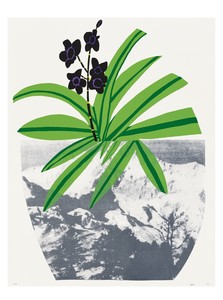
Jonas Wood, Untitled, 2014, lithograph and 7-color screen print on white Coventry rag paper, 48 × 37 inches (121.9 × 94 cm), edition of 50. Photo: Douglas M. Parker Studio
JSYou could see your drawing underneath and you could just keep adding. Some of those prints—the one that’s a self-portrait, I think you drew that six times.
JWYeah, the self-portrait has a lot of depth to it.
JSThat was in the acid six different times, which is the way to build it up.
JWYes. So the set of 8 Etchings basically documented my whole learning experience. And I remember telling you how much it was informing my painting. I was really focusing on mark-making in my painting that was relating to mark-making in the etching.
We ended up working from four paintings that were already finished and four paintings that I was in the process of making. So the etchings felt like studies for those unfinished paintings. I didn’t even know what chine-collé was before that. I always assumed you printed right onto white paper, until you explained the whole chine-collé process, which was an important part of how you make a lot of your prints.
JSYes.
JWAnd that really added so much depth to the print, just having a slightly different color of Japanese rice paper to print on. And the technique of printing on that, and then gluing it down—I didn’t understand any of that stuff, I was just going with the flow, and you were such a great teacher. That was 2014, right?
JSYes. And around that time, there was a second acquisition of my archive, by MoMA in New York. When they reached out, I felt, well, I’m kind of done now, you know? I’ve been printing for forty-two years.
JWYeah, you told me you were retiring.
JSAnd you said, “Well, maybe you want to do something with me,” and I said, “Well, yeah, as long as I don’t have to do production.”
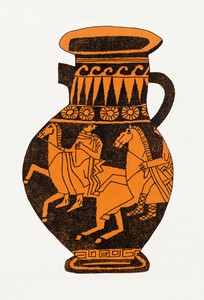
Jonas Wood, Untitled (from 8 Pots), 2017 (detail), etching with chine-collé on white Somerset satin paper, in 8 parts, each: 16 × 14 inches (40.6 × 35.6 cm), edition of 15. Photo: Brian Forrest
JWSix or eight months later we decided to make a set of pot prints. And we started with this one Greek pot with an orange background. We got halfway through and you decided it was time to retire. You thought I should continue working with Sam, who was your apprentice.
JSSam Gessow.
JWHe had worked with you for a long time and had worked with us on the etchings. Then Sam and I worked together for a year. We got a lot of work done.
JSWe did two prints. We did a Snoopy-in-the-airplane pot.
JWYes. And that was when you and I decided to publish my work, no other artist’s. And we had Sam working for a year on this set of 8 Pots [2017], which were similar in style, but this time we used colored papers and some colored ink.
JSExactly.
JWAt first we were going to make all these pots black and white, but then we wanted one of the Greek pots to be orange, which led to investigating different-color gampi papers, in slightly brown and slightly pink.
JSYes.
JWAnd having the pots be cut out was a big deal.

Jonas Wood, French Open, 2012, 4-color letterpress print on Crane’s Lettra paper, 8 × 11 inches (20.3 × 27.9 cm), edition of 20. Photo: Brian Forrest
JSIn your previous paintings show at David Kordansky Gallery in LA [2014–15], there was a beautiful big pot painting that was a whitish silver paint on black, and that opened up a lot of possibilities too.
JWOriginally we were going to make four pots and four landscape pots, but then we ended up just making eight pots. For one, we printed white ink on black paper, and it was spectacular. And for another one we printed brown wood grain on brown paper. Sam printed those with us, and a couple of other prints at the same time too.
JSYes, one cutting print and a notepad print.
JWHe made an orchid and a little doodle etching that was more in line with the prints I made with Hamilton. And Sam finished off the year with the Jungle Kitchen [2017] etching, which was based on the painting that was in my last show at David Kordansky Gallery in fall 2017. That was everything I’ve learned with you in one print. When we first started, my inclination was to try to figure out how to make flat planes, and then we ended up doing this last print with a series of eight to ten aquatint planes, all gray tonalities on top of the hard-ground etching.
JSThere’s also soft-ground etching there as well, so it’s hard ground, soft ground, and aquatint.
JWThat’s right. Well, that takes us to where we’re at right now. We’ve been talking about making a couple more interiors with this kind of density and then maybe even some landscapes. And we’ve just started dabbling with color in the small orchid and the doodle, which is new.
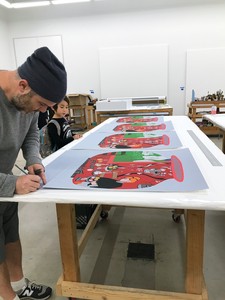
Jonas Wood signing an edition of the screen print Matisse Pot 2 (2018) with his son Kiki in Wood’s studio, Los Angeles, February 2018. Photo: courtesy Wood Kusaka Studios
JSWe need to do some color aquatint as well.
JWYeah. Sam and I were doing the color ones because we wanted to make some color landscapes with that fine saturated line. And now we’re starting to work with Kevin, Daniel, and a new etching person to make some more prints. We can’t stop.
JSThe main thing is that we have a good time.
JWYes, it’s always fun. Also, we’ve never really had any time constraints, which is good. It just seems more natural. And I’ve gotten better at actually etching so things go quicker now.
JSYou know, it’s a bit unusual for an artist to have their own print workshop, most just work with existing publishers. But when Sam Francis hired me all those years ago, in 1981, to be his printer, the first thing he said to me was, “There are no time constraints. This is an artist’s studio. We’re not making prints for publishers and we’re not making prints for dealers, we’re making prints for ourselves. Whatever it takes to get it right, that’s what we’re going to do.” And he even said to me, “I don’t care if we release any prints. I just want to work and see what we can do.” And so that’s always been my attitude.
JWI like that. And printmaking is informing my other work a lot. I’ve never made sculpture—maybe I will one day, but an artist like Ed Ruscha, for instance, has a really rich combination of printmaking, drawing, and painting all informing each other, and there’s a lot there for me to dig into. So for me it makes sense to have this be an extension of my practice, instead of working in a print shop, where there’s a deadline. This way I can experiment and learn new things. Before 2017, I had never done soft ground before, I had never done aquatinting before. We were only doing hard ground. And there are so many other things that I haven’t even learned about yet in printmaking. It just seems like there’s a big world ahead of me in printmaking. There aren’t a lot of young people making prints. And I like the idea of establishing that for myself, and also hopefully for other people in the future as time goes on, so I can do the same thing for a young artist that Ruscha did for me. And there are amazing printers in LA, but it’s kind of a dying art form.
JSWe’re another generation.
JWYeah, another generation. We’ve got to start some new stuff up.
JSAnd get people excited. Make it real for younger artists.
JWExactly.
Artwork © Jonas Wood; Jonas Wood: Prints, Gagosian, 976 Madison Avenue, New York, April 5–May 25, 2018
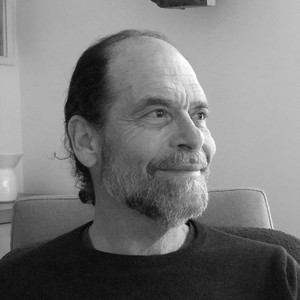
Jacob Samuel’s imprint Edition Jacob Samuel (EJS) was established in 1988 and published sixty-five series of prints by sixty artists before closing in 2015. Archives of EJS publications are included in the Los Angeles County Museum of Art, the Hammer Museum, Los Angeles, and the Museum of Modern Art, New York. In 2016 he began working with Jonas Wood on prints by WKS Editions.

Jonas Wood’s first print survey at Gagosian, New York, demonstrates his intuitive synthesis of painting and printmaking. His scenography, collage, and patterning contain gestures toward narratives both real and imagined, while maintaining a graphic deftness and a lively sense of wit.
Join Jonas Wood on a virtual tour through the creation of his first solo exhibition in Hong Kong. Wood narrates the genesis and development of the new paintings, drawings, and wallpaper.
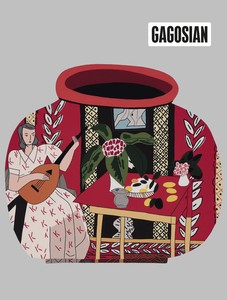
The Spring 2019 issue of Gagosian Quarterly is now available, featuring Red Pot with Lute Player #2 by Jonas Wood on its cover.
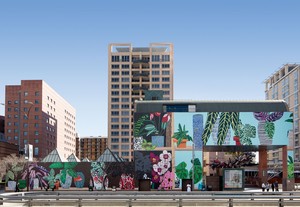
In Los Angeles, the Museum of Contemporary Art’s 5,400-square-foot façade now hosts a vibrant mural by one of the city’s own artists. Meredith Mendelsohn reports on the impact the mural has on revitalizing the museum’s exterior and downtown.
Join Gagosian for a conversation between director, producer, and writer Sophia Heriveaux and actor, director, and writer Roger Guenveur Smith inside the exhibition Jean-Michel Basquiat: Made on Market Street, at Gagosian, Beverly Hills. Heriveaux and Guenveur Smith both share a personal connection to Basquiat: Heriveaux is the artist’s niece and Guenveur Smith was one of his friends and collaborators. The pair discuss Basquiat’s work and legacy, as well as his lasting impact on contemporary art and culture.
Join Brooke Holmes, professor of Classics at Princeton University, and Lissa McClure and Katarina Jerinic, executive director and collections curator, respectively, at the Woodman Family Foundation, as they discuss Francesca Woodman’s preoccupation with classical themes and archetypes, her exploration of the body as sculpture, and her engagement with allegory and metaphor in photography.
In conjunction with Marks and Whispers, at Gagosian, Rome, Oscar Murillo and Alessandro Rabottini sit down to discuss the artist’s paintings and works on paper in the exhibition, as well as how the show emphasizes the formal, political, and social dimensions of the color red in Murillo’s work of the last decade.
In this video, Gagosian presents a conversation between Jordan Wolfson and Johanna Burton, Maurice Marciano Director of the Museum of Contemporary Art, Los Angeles. The pair discuss Wolfson’s animatronic work of art Body Sculpture (2023).
Gagosian hosted a conversation between Louise Bonnet and Stefanie Hessler, director of Swiss Institute, New York, inside 30 Ghosts, the artist’s exhibition of new paintings at Gagosian, New York. The pair explores the work’s recurring themes—the cycles of life, continuity and the future, and death—and discuss how the conceptual and pictorial structures Bonnet borrows from seventeenth-century Dutch still-life painting converge to form a metaphor for hard labor, basic animal urges, and the things we often try, but fail, to hide.
In conjunction with Franz West: Papier, the gallery’s presentation of paper-based works by Franz West at Frieze Masters 2023, artist Oscar Murillo and arts writer, critic, and broadcaster Ben Luke sit down to discuss Murillo’s collaboration in selecting the works on view, as well as his personal experiences meeting the late artist in London.
In conjunction with the exhibition The Painter in His Bed, at Gagosian, New York, Georg Baselitz and Richard Calvocoressi discuss the motif of the stag in the artist’s newest paintings.
Gagosian and Beyond Baroque Literary | Arts Center hosted a conversation between poets Jerome Rothenberg and Charles Bernstein inside Anselm Kiefer’s exhibition Exodus at Gagosian at Marciano Art Foundation, Los Angeles. Rothenberg and Bernstein explored some of the themes that occupy Kiefer—Jewish mysticism, the poetry of Paul Celan, and the formulation of a global poetics in response to the Holocaust—in a discussion and readings of their poetry.
In celebration of the centenary of Roy Lichtenstein’s birth, Irving Blum and Dorothy Lichtenstein sat down to discuss the artist’s life and legacy, and the exhibition Lichtenstein Remembered curated by Blum at Gagosian, New York.